- News
- Elections News
- Why Congress and JD(S) alliance in Karnataka may not be a worry for BJP
This story is from April 23, 2019
Why Congress and JD(S) alliance in Karnataka may not be a worry for BJP
The “success” of the post-poll alliance in Karnataka assembly elections prompted the Congress and JD(S) to replicate the formula for the 2019 Lok Sabha polls as well. However, a look at the voting pattern of the previous Lok Sabha polls indicate that the alliance may find it difficult to deliver on its objective.
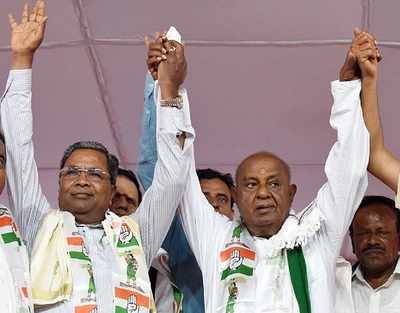
Key Highlights
- The success of Congress-JD(S) alliance in assembly elections, prompted the two parties to forged the same for Lok Sabha polls
- A constituency-by-constituency breakup of the vote share of each of these three parties reveal that the current Congress-JD(S) alliance is unlikely to show gain
NEW DELHI: In 2018 Karnataka assembly elections, the Congress, with 80 seats, forged a post-poll alliance with JD(S), with 37 seats, to form a government in the 224-member assembly. The BJP with 104 seats was the single largest party.
The “success” of this alliance prompted the two parties to replicate the formula for the 2019 Lok Sabha polls as well.
However, a look at the voting pattern of the previous Lok Sabha polls indicate that the alliance may find it difficult to deliver on its objective.
By analysing the vote shares of all the three political parties, it appears that the alliance strategy was conceived to defend the number of seats, rather than increase the tally.
In terms of vote share, BJP got 43% votes, followed by Congress, 40.80% and JD(S), which received 11.00% votes.
A look at these numbers suggest that if Congress and JD(S) were in alliance in 2014, they would have been ahead of the BJP by 8.8% votes.
However, a constituency-by-constituency breakup of the vote share of each of these three parties reveal that the current Congress-JD(S) alliance is unlikely to show gain, if the 2014 voting patterns do not change substantially.
If one assumes that all the votes of JD(S) will transfer to Congress and vice versa, then also the alliance was unable to wrest a majority of the seats won by BJP in 2014.
(On two seats – Dakshini Kannada and Koppal – JD(S) had not fielded a candidate. Hence, they have been excluded from the analysis)
A look at the votes polled by each of these three parties in 2014 reveal that the alliance, with its combined vote share, will be “unsuccessful” in wresting as many as 11 seats out of the 17 won by the BJP in the last general elections. Assuming that there is no dip in BJP’s share of votes.
In these seats, the BJP’s vote share was more than the combined vote share of Congress and JD(S).

There were only two seats – Mysore and Davanagere where the alliance seems to be achieving its desired objective.
The decision to forge an alliance may not help the Congress and JD(S) to up its 2014 tally. However, it will definitely help both the parties to defend the seats they won in 2014.
In other states ,the vote base of political parties is spread evenly across the states. In Karnataka, the vote base of various political parties, especially JD(S), is a very localised. JD(S) is considered to be a "South Karnataka only" party. Hence, it is not possible for the alliance to counter the BJP in regions where JD(S) doesn't have a sizeable presence.

An analysis of the nine seats won by the Congress shows that both the JD(S) and the Congress have sizeable presence in these constituencies. On these seats, the Congress will become more formidable an opponent to the BJP, if it is successful in securing the JD(S) votes.
Additionally, a look at the caste structure of the state would reveal that both the Congress and the JD(S) are aiming at the same group of castes — minorities, backward classes and dalits. The BJP, on the other hand, is known to rely on the support of Lingayat-Vokkaliga-Brahmin combination.

For example in Tumkur, where JD(S) has decided to take on the BJP as part of the seat-sharing agreement, the alliance received 62.4% of the votes in 2014. The BJP received 32.3% votes. Thus making the contest a one-sided affair.
Similarly in Hasan, which was won by JD(S) in 2014, the combined vote share of JD(S), 44.40% and Congress, 35.6% is no match for the BJP, which could garner a mere 14.4% votes.

However, the success of the alliance will also depend upon the transferability of the votes between the Congress and the JD(S). The alliance was forged with an objective to keep BJP out of power. However, it is to be seen if the anti-BJP agenda finds resonance with the common man on the ground and is sufficient to compel them to change party loyalties and vote for a different party.
The “success” of this alliance prompted the two parties to replicate the formula for the 2019 Lok Sabha polls as well.
However, a look at the voting pattern of the previous Lok Sabha polls indicate that the alliance may find it difficult to deliver on its objective.
By analysing the vote shares of all the three political parties, it appears that the alliance strategy was conceived to defend the number of seats, rather than increase the tally.
In 2014 general elections, BJP won 17 of the 28 Lok Sabha seats in the state. Congress was second with nine seats, while the JD(S) was a distant third with two seats.
In terms of vote share, BJP got 43% votes, followed by Congress, 40.80% and JD(S), which received 11.00% votes.
A look at these numbers suggest that if Congress and JD(S) were in alliance in 2014, they would have been ahead of the BJP by 8.8% votes.
However, a constituency-by-constituency breakup of the vote share of each of these three parties reveal that the current Congress-JD(S) alliance is unlikely to show gain, if the 2014 voting patterns do not change substantially.
If one assumes that all the votes of JD(S) will transfer to Congress and vice versa, then also the alliance was unable to wrest a majority of the seats won by BJP in 2014.
(On two seats – Dakshini Kannada and Koppal – JD(S) had not fielded a candidate. Hence, they have been excluded from the analysis)
A look at the votes polled by each of these three parties in 2014 reveal that the alliance, with its combined vote share, will be “unsuccessful” in wresting as many as 11 seats out of the 17 won by the BJP in the last general elections. Assuming that there is no dip in BJP’s share of votes.
In these seats, the BJP’s vote share was more than the combined vote share of Congress and JD(S).

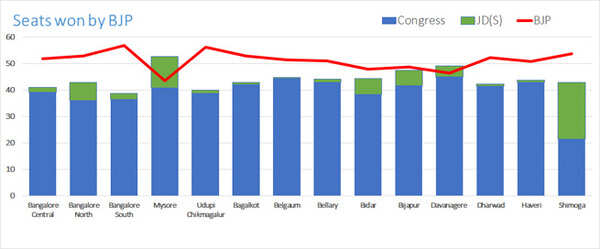
There were only two seats – Mysore and Davanagere where the alliance seems to be achieving its desired objective.
The decision to forge an alliance may not help the Congress and JD(S) to up its 2014 tally. However, it will definitely help both the parties to defend the seats they won in 2014.
In other states ,the vote base of political parties is spread evenly across the states. In Karnataka, the vote base of various political parties, especially JD(S), is a very localised. JD(S) is considered to be a "South Karnataka only" party. Hence, it is not possible for the alliance to counter the BJP in regions where JD(S) doesn't have a sizeable presence.
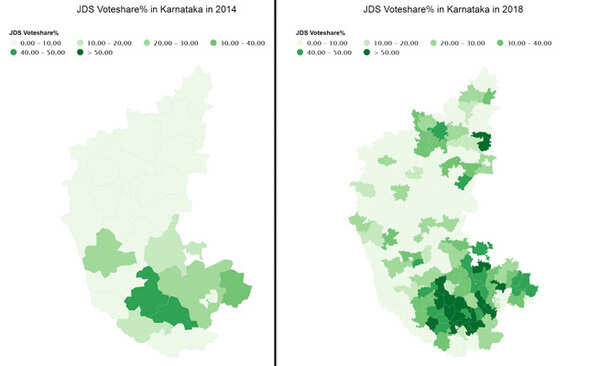
An analysis of the nine seats won by the Congress shows that both the JD(S) and the Congress have sizeable presence in these constituencies. On these seats, the Congress will become more formidable an opponent to the BJP, if it is successful in securing the JD(S) votes.
Additionally, a look at the caste structure of the state would reveal that both the Congress and the JD(S) are aiming at the same group of castes — minorities, backward classes and dalits. The BJP, on the other hand, is known to rely on the support of Lingayat-Vokkaliga-Brahmin combination.
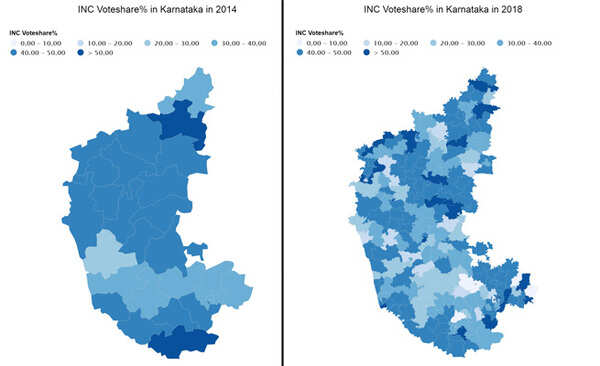
For example in Tumkur, where JD(S) has decided to take on the BJP as part of the seat-sharing agreement, the alliance received 62.4% of the votes in 2014. The BJP received 32.3% votes. Thus making the contest a one-sided affair.
Similarly in Hasan, which was won by JD(S) in 2014, the combined vote share of JD(S), 44.40% and Congress, 35.6% is no match for the BJP, which could garner a mere 14.4% votes.
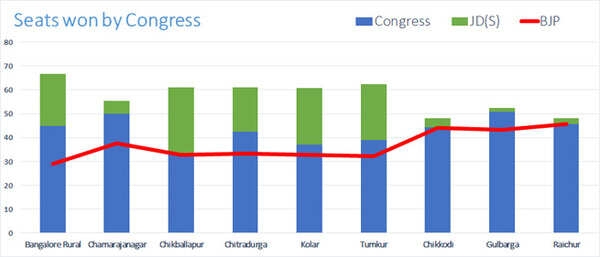
However, the success of the alliance will also depend upon the transferability of the votes between the Congress and the JD(S). The alliance was forged with an objective to keep BJP out of power. However, it is to be seen if the anti-BJP agenda finds resonance with the common man on the ground and is sufficient to compel them to change party loyalties and vote for a different party.
End of Article
FOLLOW US ON SOCIAL MEDIA
